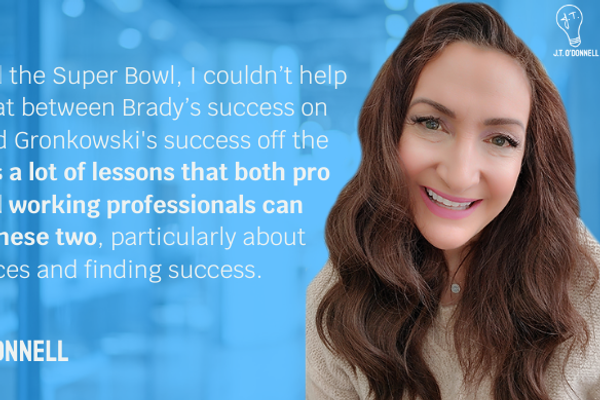
So, just what is thought leadership in the context of a job search? Let's start with a few sample definitions.
RELATED: 7 Ways To Improve Your Failing LinkedIn Strategy
The term “thought leadership" was first coined by Joel Kurtzman, then Editor-in-Chief of Booz& Co's Strategy & Business Magazine. Wikipedia defines a thought leader as “an individual that is recognized as an authority in a specialized field whose expertise is sought and often rewarded." Daniel Rasmus described thought leadership a little differently in his Fast Company.com article, The Golden Rules for Creating Thoughtful Thought Leadership, “Thought leadership should be an entry point to a relationship. It should help start a relationship where none exists, and it should enhance existing relationships." Michael Brenner noted in his LinkedIn post, “What is Thought Leadership? Why You Need It. And Steps to Get it Right," that “thought leadership is about becoming an authority on relevant topics by delivering the answers to the biggest questions on the minds of your target audience." Brenner raises a good point in that demonstrating thought leadership is ultimately about answering relevant questions. Which leads me to the reasons why thought leadership is worthy of a job seeker's time – because demonstrating your expertise on key issues in your industry can help attract recruiters and hiring executives to your candidacy. Think about it this way. If your candidacy is the proverbial needle in a haystack, then to get the attention of recruiters and hiring executives you need to somehow clone yourself to make it easier for them to discover you. Thought leadership is the perfect solution. Done right, this strategy helps your target market to find you, to get to know you, and to validate your knowledge when compared to other candidates. That's no small thing in a market in which there are three unemployed persons for every job opening and 250 applicants for every corporate job posting (for the full infographic see CareerEnlightenment.com). Okay, so maybe you understand why thought leadership is important for job seekers to consider. But why is it important to do so on LinkedIn? Well, if that's the #1 place where recruiters and hiring executives are looking for candidates (and it is), then it makes sense to focus your initial thought leadership efforts on LinkedIn. Don't limit yourself to this social media site, however; consider adding Twitter and other valuable sites such as Quora as your comfort level with thought leadership grows. Before we review the key ways to build thought leadership on LinkedIn, I'd like to reference some key points Brenner made in the article I referenced earlier. He suggests that thought leadership needs to focus on five key elements. His ideas deserve a full attribution in this quote “translated" to relate to job seekers:
- First, identify the questions that recruiters and hiring executives are asking themselves about prospective candidates. Identify as many as you can and prioritize them.
- Second, strategize ways to answer those questions across multiple formats and channels in a way that adds value to your audience. Start with the most important questions and work your way down the list. All you have to do is have the right content to answer the basic questions.
- You have to “give to get" so share your expertise generously.
- Make your content interesting to rise above the boring and overly promotional content that is bombarding your audience. Educate your audience while entertaining them in the process. Tell stories. Use examples.
- Invite recruiters and hiring executives to participate in your content. Interview customers and other key stakeholders or curate content from other sources while adding your own perspective.
LinkedIn Status Updates
Use the status updates feature found on your LinkedIn home page to share thought leadership content. Ask relevant questions. Solicit information and opinions. Promote blog posts and articles written by others while commenting with your own unique perspective. Remember, if you use Twitter, you can link that account to LinkedIn so your status updates are pushed to both social media sites at the same time. Otherwise you can publicize your status update to the entire LinkedIn membership or just your network. I recommend choosing the whole LinkedIn membership if possible because your exposure will be magnified significantly.LinkedIn Groups
First, join as many groups related to your career brand as you can. Stay active in the best groups and contribute to the discussions started by others. Begin launching your own discussions and/or share resources and ideas. This thought leadership strategy is similar to the status update strategy except it's more focused – only the members of each group will see your discussion posts. Since recruiters sometimes “troll" these groups for candidates, this strategy will help you to stand out from the crowd.LinkedIn Profile
You already know that a brand-focused, key word-driven profile is critical for social networking success, right? To showcase your thought leadership in your profile you'll need to do a few extra things:- Embed several key words relevant to your thought leadership in your profile headline.
- Use your summary to showcase the impact your thought leadership has had on your current/past employers. Be specific and use quantifiable facts.
- Add your thought leadership topic areas to the skills list you have embedded in your summary and each position.
- If you blog or author articles or guest posts for online sites/publications, list those in your profile and include links to each one. If you use key word-rich titles for your posts and articles you will automatically be adding more key words to your profile.
- If you're reluctant to blog or want to and don't know how to start, consider guest blogging an effective way to get your feet wet. Learn how guest blogging can bolster your career brand and extend your thought leadership reach.









